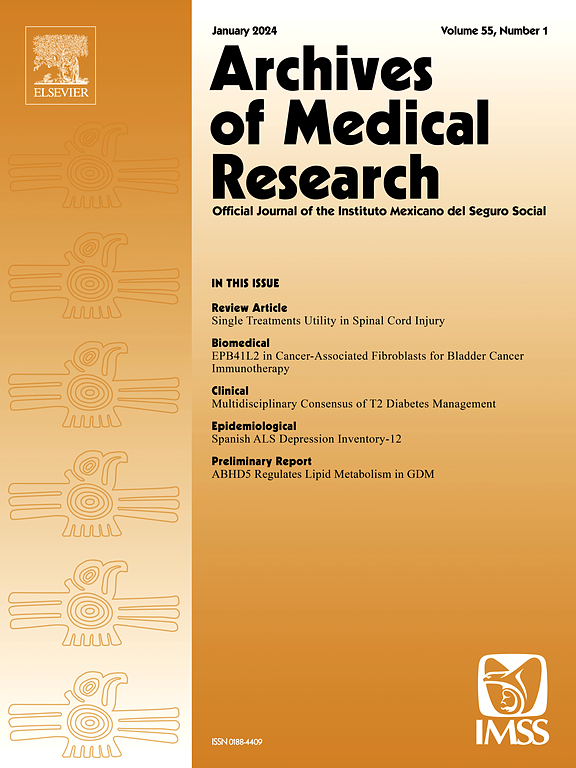Deep Venous Thrombosis in Patients Recovered from COVID-19: A Long-Term Sequel
IF 3.4
3区 医学
Q1 MEDICINE, RESEARCH & EXPERIMENTAL
引用次数: 0
Abstract
Background
Severe acute respiratory syndrome coronavirus 2 (SARS-CoV-2), also known as COVID-19 disease has the ability to generate sequelae that extend for weeks or months, giving rise to long-term COVID-19 disease. This condition reduces patients’ quality of life and predisposes them to several alterations, including failures in the blood coagulation system. Our laboratory has previously demonstrated abnormalities in endothelial colony-forming cells (ECFCs) of patients recovered from COVID-19.
Objective
To analyze the functional state of ECFCs in patients who experienced venous thromboembolic disease (VTD) or arterial thrombosis (AT) during long COVID-19, or post-COVID condition (PCC).
Methods
We compared 35 samples of peripheral blood (PB) mononuclear cells (MNCs) from patients with a thrombotic event (who had a healthy lifestyle before infection and were vaccinated) with 10 healthy volunteers and 10 samples from patients with a history of recurrent unprovoked VTD (rVTD) after a COVID-19 infection. The samples were cryopreserved in our laboratory and matched by age 25–50 years old and sex. The frequency, morphological characteristics, proliferation and angiogenic ability of ECFCs were evaluated in all samples.
Results
There were no significant differences between male and female patients, and the laboratory data did not indicate risk factors for VTD or AT. The frequency of ECFCs was not different between controls and patients, but a reduced proliferative capacity, a high percentage of senescence and non-angiogenic activity were observed in VTD samples.
Conclusions
Our results demonstrate a strong association between VTD events in patients with PCC who had a healthy lifestyle prior to infection and ECFCs dysfunction.
COVID-19康复患者的深静脉血栓形成:一个长期的后遗症
严重急性呼吸综合征冠状病毒2 (SARS-CoV-2),也称为COVID-19疾病,能够产生持续数周或数月的后遗症,从而导致长期的COVID-19疾病。这种情况降低了患者的生活质量,并使他们容易发生一些变化,包括凝血系统的故障。我们的实验室之前已经证实了COVID-19康复患者的内皮集落形成细胞(ecfc)异常。目的分析长时间COVID-19或COVID-19后状态(PCC)中发生静脉血栓栓塞性疾病(VTD)或动脉血栓形成(AT)患者ecfc的功能状态。方法将35份来自血栓形成事件患者(感染前生活方式健康并接种疫苗)的外周血(PB)单核细胞(MNCs)样本与10名健康志愿者和10份来自COVID-19感染后复发性无因性VTD (rVTD)患者的样本进行比较。样本在我们的实验室冷冻保存,并按年龄25-50岁和性别匹配。在所有样本中评估ecfc的频率、形态特征、增殖和血管生成能力。结果男性和女性患者之间无显著差异,实验室数据未显示VTD或AT的危险因素。ecfc的频率在对照组和患者之间没有差异,但在VTD样本中观察到增殖能力降低,衰老和非血管生成活性的高比例。结论研究结果表明,感染前生活方式健康的PCC患者的VTD事件与ECFCs功能障碍有很强的相关性。
本文章由计算机程序翻译,如有差异,请以英文原文为准。
求助全文
约1分钟内获得全文
求助全文
来源期刊

Archives of Medical Research
医学-医学:研究与实验
CiteScore
12.50
自引率
0.00%
发文量
84
审稿时长
28 days
期刊介绍:
Archives of Medical Research serves as a platform for publishing original peer-reviewed medical research, aiming to bridge gaps created by medical specialization. The journal covers three main categories - biomedical, clinical, and epidemiological contributions, along with review articles and preliminary communications. With an international scope, it presents the study of diseases from diverse perspectives, offering the medical community original investigations ranging from molecular biology to clinical epidemiology in a single publication.
 求助内容:
求助内容: 应助结果提醒方式:
应助结果提醒方式:


